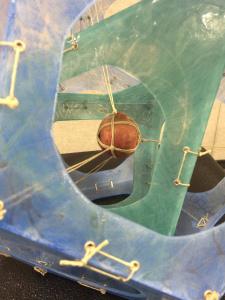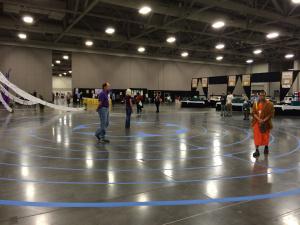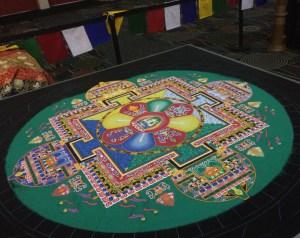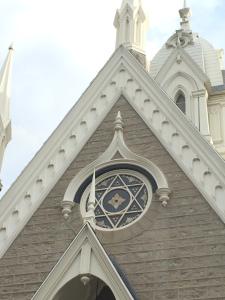
99 Names Project. Artist, Andrew Kosorok. Parliament art exhibit.
What if I told you that almost 10,000 people converged on Salt Lake City for the Parliament of the World’s Religions, to engage in interfaith activism, interfaith education and interfaith bridge-building? And what if I reminded you that more than a third of all Americans who are married or living with a partner are in interfaith or mixed-denomination relationships according to Pew Research? Given these two pieces of information, you might expect robust discussion at this Parliament on the role of interfaith families as interfaith educators and peacemakers. Am I right?

Registration Hall, Salt Palace Convention Center, Parliament of the World’s Religions
The Parliament can be overwhelming: it helps to have a thread, a focus, to organize your days. I approached the Parliament through my own lens, that of an adult interfaith child who claims a complex religious identity. So on my first day in the Salt Palace Convention Center, I went looking for the stories of people from interfaith families inspired to become interfaith peacemakers. And of course, I found them, everywhere.
But not in the official program. The official program contained some 600 presenters giving some 300 presentations, and there was exactly one session on the role of interfaith families. That would be: my presentation. Why only one? Like so many other old-school interfaith organizations, the Parliament has traditionally been dominated by older men–I witnessed a panel composed entirely of men in dark suits at the opening plenary–and by religious institutions interested in keeping everyone in a “Box A or Box B or Box C” model of religious affiliation.
Those of us who blur boundaries, who claim Buddhism and Christianity, or Judaism and Paganism, or create families that transgress the invisible religious borders–we make religious leaders nervous. We are disruptors, even at a conference as radically inclusive as the Parliament. We are seen as marginal, even while we are now the majority in some religious communities, even while millennials are fleeing from “either/or” identities, and from religious litmus tests, and dogma, and membership criteria.

Labyrinth, Salt Palace Convention Center, at the Parliament
So, I woke up early on my first full day at the Parliament (thanks to East Coast jet lag) and set out to find my interfaith family people. And in the very first session into which I wandered, Buyondo Micheal was explaining The Peace Drum Initiative, a project in which he teaches Muslim, Christian, and Hindu schoolchildren in Uganda to drum together, under the auspices of his Faiths Together Uganda program. As he began explaining how he ended up creating this program, he described his own interfaith education as part of an interfaith family, in which he shifted back and forth from Christian to Muslim schools throughout his childhood. Lo and behold, the very first presenter I heard at the Parliament turned out to be someone from an interfaith family, inspired by this background to do interfaith peacemaking.

Tibetan Buddhist sand mandala, Registration Hall, Salt Palace Convention Center
Next, I lined up for langar, the lunch served by the Sikh community each day, and ended up sitting on the floor eating with a local woman who was volunteering at the Parliament, from a Mormon and Catholic interfaith family. (In the langar line on another day, I ran into a friend from my online interfaith activism world, from a Hindu and Sikh interfaith family). Each day while waiting in the langar line, I watched the sand mandala made by the Tibetan Buddhist monks slowly taking shape. The intricate patterns seemed to reflect the complexity of the interfaith world, and my own interfaith identity.
After curried potatoes, spicy cauliflower and chai tea at langar, I went to give my talk on interfaith families as interfaith peacemakers. During the discussion, the young woman who was randomly assigned as a volunteer to our session, who was there to make sure the projector worked, raised her hand tentatively. She said, “I didn’t even know what this session was going to be about. But I’m an interfaith child. My parents are Mormon and Baha’i. And I’ve never heard anyone talk about it in this way before. I thought I was the only one. So I just wanted to thank you.” That moment, right there, made the trip to Salt Lake City worthwhile.
Each of these Parliament participants born into an interfaith family was motivated to walk through the doors of the Salt Palace because of, not in spite of, their experiences as interfaith bridge-builders in their own families. But I only got a glimpse of these inspiring stories in the liminal spaces—in the lunch line conversations, and as tangents. At the next Parliament, we need to hear about the rich complexity of interfaith family life in multiple panels, and in the plenary sessions.

Assembly Hall, Temple Square, Salt Lake City
Susan Katz Miller’s book, Being Both: Embracing Two Religions in One Interfaith Family is available now in hardcover, paperback and eBook from Beacon Press.

